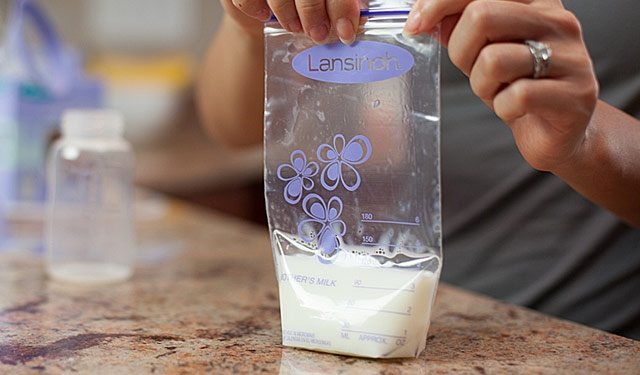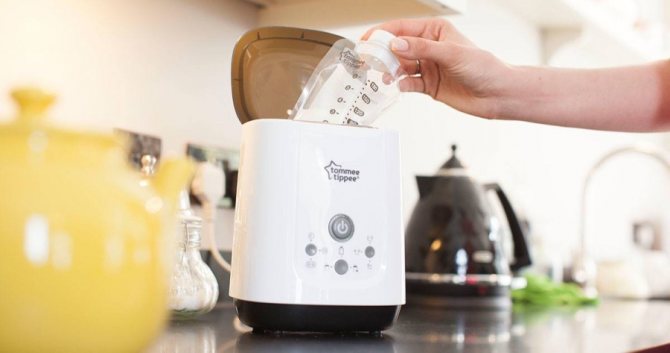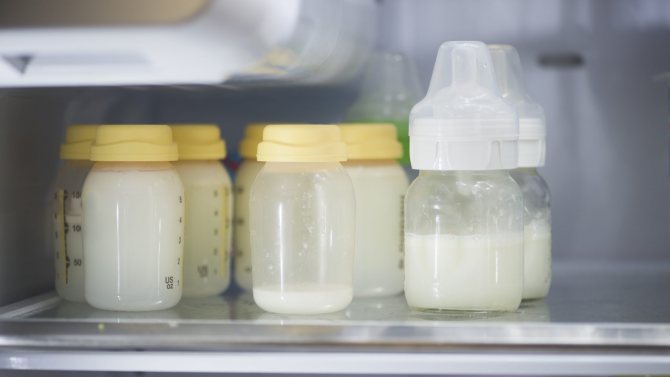Storing expressed breast milk: rules, tips, cautions
There are many situations in which a mother cannot feed her baby milk directly from the breast. Forced early return to work, the need to leave on business, leaving the baby with dad or grandma, the baby’s poor health, because of which he flatly refuses to breastfeed, inflammatory processes in the woman’s mammary gland (lactostasis, mastitis) and dozens of other circumstances , in which there is nothing tragic from the point of view of the well-being of the mother and baby, since expressed milk can be stored in appropriate conditions for up to one year without losing its freshness, taste and nutritional value.
Hand expression technique
How to express breast milk by hand? Before you begin this important task, preparation is necessary. If you need more milk to be released, pumping should be done next to the baby or his photograph, with thoughts about him, and best of all, touching the baby. 10-15 minutes before this, you can drink warm tea or water, massage your breasts a little, or let your baby touch your breasts. A warm shower stimulates lactation well. Hands must be washed with soap.
The thumb is placed on top of the areola, approximately 3 cm from the nipple, the index and ring fingers are located below, opposite the thumb, with the same distance from the nipple. With a gentle but confident movement, the chest is squeezed with your fingers in the direction of the ribs, i.e. back, after which the fingers roll forward, towards the nipple - at this moment the milk is squeezed out. Then everything is repeated.
- Don’t feel sorry for yourself, press your chest confidently. It might hurt the first time. When expressing correctly, milk flows out in streams, not drops;
- move your fingers around the orales to extract milk from all the lobules;
- Be careful not to let your fingers slip onto the nipple, as it could injure him. If the milk makes your skin very moist, dry your breasts and arms, and then continue pumping;
- Do not express milk until the very last drops, but until your breasts are relieved and empty.
How to express breast milk manually is usually explained in the maternity hospital, but if difficulties arise with expressing, be sure to consult your gynecologist.
How to store breast milk after pumping
Note that the very composition of breast milk protects it from rapid souring. Therefore, if you expect to feed your child for several hours, it is quite acceptable to pour the product into an airtight container and leave it indoors. At a temperature of +23-25 ºС it will not spoil within 4 hours, and if the room or kitchen is a little cooler, for example +19-22 ºС, the shelf life of expressed breast milk increases to 6-10 hours.
For longer periods, you will have to use a refrigerator or even a freezer. Here the rules are as follows:
- Safe for a child, storing expressed milk in the refrigerator at a temperature of +2-4 ºС can reach 7 days. To do this, it should be poured into a well-washed container, sealed tightly and placed in the coldest place, usually at the back wall above the vegetable compartment. Before heating, the bottle or container must be gently shaken several times so that the separated product acquires its original uniform texture;
- The temperature of the freezer compartment in single-chamber refrigerators is minus 12-14 degrees. In such a freezer, the shelf life of expressed breast milk can be up to 3 months. It is advisable to load a product pre-cooled in the refrigerator into the freezer;
- in 2-chamber refrigerators, the freezer is capable of maintaining a stable temperature of -18 ºС and below, so here mother’s milk can be safely stored for six months, or even a year. The rules for pre-cooling are the same as in the previous method.
Thermal containers become a compromise option for mothers who spend a lot of time with their child, but outside the home. They are able to maintain a temperature of +10-15 degrees, which means that the dairy product placed in them will remain fresh and suitable for consumption for about a day.
Containers for storing expressed breast milk: where to stop?
Manufacturers of goods for children offer a very diverse range of containers in which milk can be stored both for several hours and for quite a long time. These include plastic containers, glass food containers, and breast milk bags.
Any of these options is safe and acceptable if certain conditions are met:
- the container must be clean, absolutely dry and tightly closed;
- It is better to check the strength of the bags in advance - if the seams do not withstand the tensile load, when the milk freezes and, accordingly, its volume increases, the bag may burst and then defrosting the product will be problematic;
- You should not use your family containers for these purposes - breast milk containers are made from highly purified food grade plastic. They are subject to higher certification requirements than conventional disposable tableware for adults;
- Containers should be filled no more than three-quarters full, taking into account that liquid increases in volume when it freezes.
By the way, a regular bottle is also quite suitable for such purposes. There are no special recommendations on how to store expressed milk in a bottle: everything listed above remains relevant and effective for this option.

Tip: Always write the date and time you pumped on the container, especially if you are storing multiple portions of milk.
This way you can, firstly, control the shelf life, and secondly, select for mixing the portions that are closest in time to receipt, and therefore homogeneous in nutrient composition.
Rules for expressing milk with a breast pump
Breast pumps have come to the aid of modern mothers - convenient devices that allow you to quickly and conveniently obtain breast milk. There are many types of breast pumps, which differ in price, mechanism of action and manufacturer (see how to choose a breast pump, review of the best ones, advantages and disadvantages of manual and electric ones).
Preparing for expressing with a breast pump is the same as for expressing by hand. The breast pump must be clean and sterile.
How to express with a breast pump correctly? These devices always come with detailed instructions on how to properly use a particular breast pump. Let's consider the general rules of mechanical pumping, since the process occurs differently when using different models.
- The breast pump funnel is placed against the breast so that the nipple is in the center.
- It is important to ensure that the funnel fits snugly against the dry skin of the breast to create a vacuum.
- Further actions depend on the type of breast pump: you need to start squeezing the pump or bulb, press the piston handle (manual breast pumps) or turn on the start button on an electric breast pump.
- Manual breast pumps require constant hand work - you need to rhythmically press the bulb, pump or piston handle.
- When using electric breast pumps, you only need to control the process by adjusting the pumping force to suit you. By the end of the process, the breasts become empty and soft, and the flow of milk becomes a trickle.
In all cases, the flow of milk should be uniform and fairly active. Expressing should not cause pain (this is only possible in the first minutes when using simple pear-type breast pumps). After the procedure, the breast pump must be washed and sterilized.
Warming up expressed milk and doing it wisely
The best option for reheating milk from the freezer is to first defrost it in the refrigerator compartment and then reheat it. If this is not possible, you can also heat the frozen product, but in this case the milk will need to be mixed very thoroughly.
For heating, you cannot use a microwave oven or pour milk into a pan and put it on the stove: when heated quickly, the expressed and cooled product loses a significant part of its nutrients. It is better to use the water bath method or simply hold the container under a tap with hot water flowing from it. The same method can be used if expressed milk was stored at room temperature - it will just take less time to warm it up.
Thawed and warmed breast milk should never be re-frozen, and the maximum period for its use is 24 hours.

Freezer storage rules
- Breast milk can be frozen. In this case, the frozen product can be stored at -15˚C for two weeks. If the freezer has a separate chamber with a constant temperature of -18˚C, then you can store milk for up to 3 - 6 months.
- Breast milk does not lose its properties when frozen. But if stored and defrosted incorrectly, it deteriorates.
- The container in which you freeze milk should not be filled to the top, especially for bags. When frozen, the liquid will expand and may burst the container.
- Use older milk to avoid milk going sour.
Testing for suitability: how to determine whether expressed milk has spoiled during storage?
Signs of unsuitability of breast milk are practically no different from signs of souring of cow, goat or any other milk. We offer several ways to determine whether your baby can be fed this milk or whether it’s time for him to go to waste:
- Smell and taste. A rotten “aroma” and sour taste indicate that in mastering the science of how to store expressed breast milk, you missed some important point and, as a result, violated the technology. Such liquid is definitely sent for disposal. Clarification: a specific “soapy” smell and taste are normal and do not harm the baby, moreover, most children do not react at all to such minor changes in taste.
- Consistency. A sign that defrosted milk is spoiled are lumps or lumps that do not dissolve when shaken. It’s definitely not worth feeding such a product to your baby.
- Warming up. The most reliable way to check is warming up. Pour some milk into a tablespoon and hold it over a lit burner. The spoiled liquid, under the influence of temperature, will disintegrate into curds and whey. You can easily make homemade cottage cheese out of it for your child, but you cannot offer him to drink such milk.
Sometimes you can come across a recommendation to pay attention to the color of the milk. In our opinion, this indicator is not entirely informative, since the shade of a product can change even throughout the day depending on a woman’s menu, which means it is impossible to compare the shade of a thawed or taken from the refrigerator product with the original one.
Current questions about pumping
Should I express breast milk from both breasts?
Depending on the goals and time for which the mother is separated from the baby, the need to pump from both breasts is assessed. If the mother leaves for 2-3 hours and has fed the baby before, milk from one breast is quite enough. If the time period is longer, both breasts are expressed.
How often should I pump?
It is not recommended to do this more often than once an hour. Optimally after 1.5-3 hours, for example, feeding one breast to the baby, and expressing the other for future use.
How many times should I pump?
Again, depending on the situation, it can be either sporadic or constant. If this is regular pumping, the mother should focus on the time periods during which the baby usually suckles. Of course, the stored milk should be enough for the child for the time that the mother plans to spend away from him.
Should I pump my breasts at night?
When separated from the baby from birth, night pumping is a prerequisite to maintain lactation, and this must be done at least once every 3 hours. The baby may not be able to drink this amount of milk, especially if he is premature, but it can always be stored for future use or, in extreme cases, thrown away if the mother does not recognize the value of frozen breast milk. In this case, the process of starting the production of further portions of milk, which is triggered by pumping, is important. If the mother no longer breastfeeds at night, then there is no need to do this at night.
How long does it take?
The manual process takes more time and lasts about 20-30 minutes, with a breast pump it takes about 15 minutes.
Is it possible to mix portions of milk obtained from several approaches?
You should not mix milk, even if one portion is 20 ml and the second is 100.
Is it possible to give milk to a child that has been stored without refrigeration for more than 4 hours?
Theoretically, milk does not spoil for up to 6 hours even at a temperature of about 25 C. But if it is summer and the bottle has been exposed to sunlight, it is better not to risk it.
Is it possible to breastfeed and express the other breast at the same time?
Technically, it’s difficult to imagine, but some mothers manage to simultaneously feed their baby and pump, citing that in this case more milk is produced. If the child does not suffer, then this is possible, but only if you express by hand. But it’s better not to do this, because you will have to constantly be distracted from the child.
Which is better - hand expression or breast pump?
From a safety point of view, a sterile breast pump is a more reliable device than the mother’s hands. But in each case everything is individual. If you express your breasts with your hands correctly, no problems will arise.
Is breast milk that has been frozen healthy?
Yes, it’s healthy, much healthier than any milk formula! But subject to the storage time, constant freezing temperature excluding changes and re-freezing, and the rules for defrosting milk. And, of course, it cannot be boiled.
Is it possible to express previously expressed milk?
Let’s not lie, in order to save time and dishes, many mothers do this, that is, they express into a bottle, put it in the refrigerator, after a couple of hours they take it out and strain the milk there.
However, according to the rules, this should not be done. The temperature of milk taken out of the refrigerator is about +3 degrees, stored at room temperature - no more than +2 ºС. At the same time, the temperature of milk just expressed from the mother’s breast is approximately equal to body temperature, that is, about 35-36 ºС. Mixing warm, cool and cold liquids with each other can lead to a reduction in shelf life, or even spoilage of milk.
Therefore, it is better to do the following: decant into separate containers each time, and mix portions that have already been cooled to the same temperature. Then your breast milk will remain fresh, nutritious and tasty for your baby for a long time.

How to defrost correctly?
Let's discuss how to defrost and warm expressed breast milk and what you should tell the person who will stay with and feed your baby.
- Frozen milk should be removed from the freezer and placed in the refrigerator. It is better to do this 12 hours before feeding.
- Chilled or defrosted milk should be heated either under running water or in a water bath, gradually increasing the temperature of the water. It is possible to warm it up in special devices for heating milk.
- Do not heat breast milk in the microwave or directly on the stove.
- Thawed milk can be stored in the refrigerator for up to 24 hours. It can only be frozen once.
- When milk is in the refrigerator, it is divided into fractions. Before heating the milk, take the bottle and stir the milk gently without shaking it.
- Do not boil breast milk.
- Don't forget to sign your pumping dates.
Follow these simple tips, and your baby will always be provided with high-quality food - breast milk. And even in those moments when a nursing mother needs to go away.











